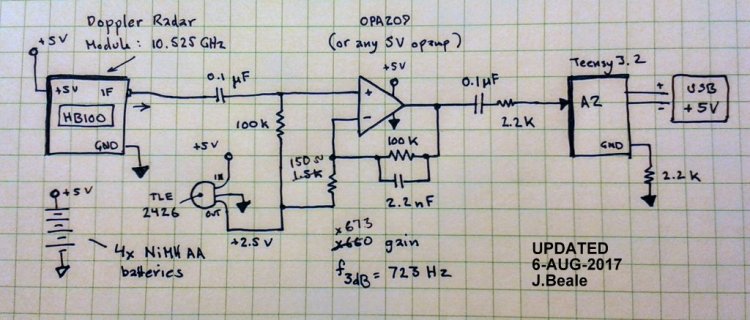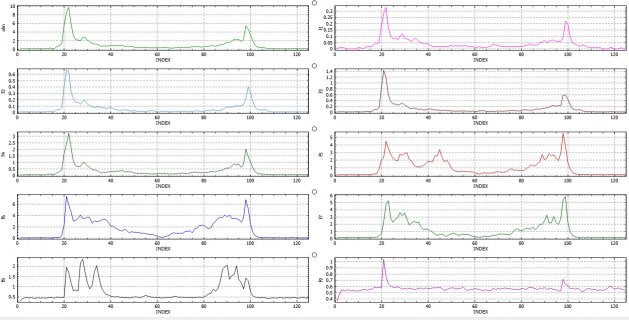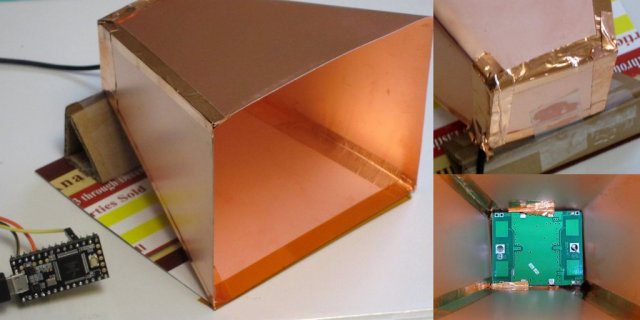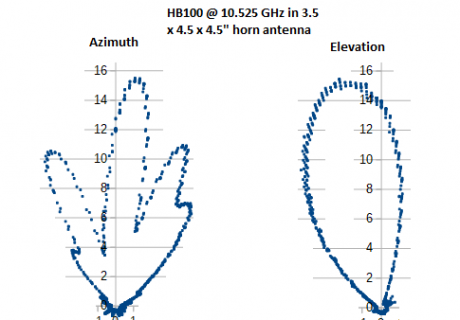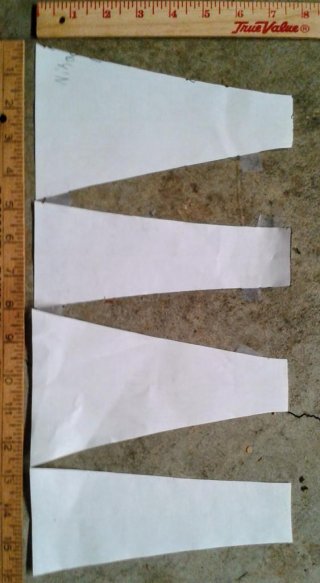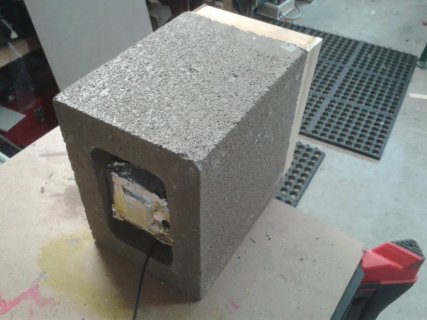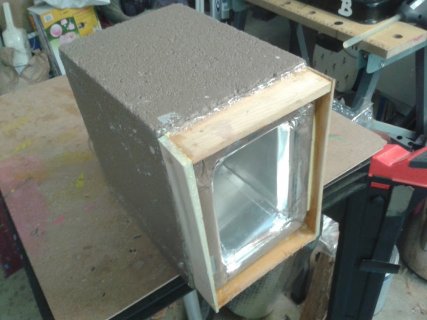Here's a use of the audio library for a non-audio purpose.
You can buy a HB100 doppler radar module for well under $5 at the usual auction sites. This sort of thing is used for automatic door openers with short range, say 10 feet. The HB100 has a mV-level baseband IF output, which I boost with a x660 opamp circuit (OPA209A) and 0.1 uF cap directly into the Teensy 3.2 pin 16 (A2). The output is a frequency proportional to target speed: Frequency (Hz) / 31.37 = Speed (mph). I use the audio library's FFT1024 object to select out just my walking speed which is 2.2 mph, which means a signal near f=70 Hz. That, plus a crude aluminum-foil-and-cardstock horn for directivity, allows a pedestrian-detection range of 80 feet, which is a considerable improvement over the "stock" sensor (esp. given radar signals drop as 1/r^4). Many thanks to Frank B for the code to cut the ADC sample rate x4 for smaller frequency bins, and neutronned for the example code I modified.
The plot below shows the 2.2 mph frequency channel as I walk directly away from the sensor out to 80 feet, then immediately return the same way.
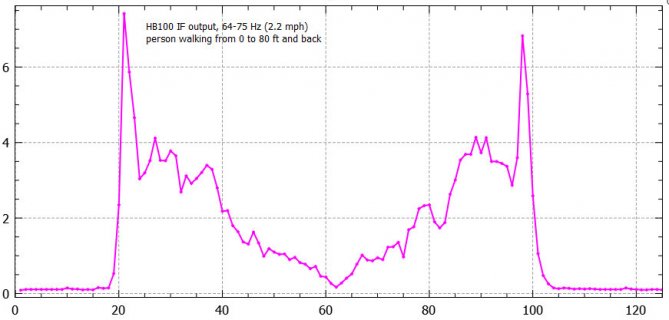

You can buy a HB100 doppler radar module for well under $5 at the usual auction sites. This sort of thing is used for automatic door openers with short range, say 10 feet. The HB100 has a mV-level baseband IF output, which I boost with a x660 opamp circuit (OPA209A) and 0.1 uF cap directly into the Teensy 3.2 pin 16 (A2). The output is a frequency proportional to target speed: Frequency (Hz) / 31.37 = Speed (mph). I use the audio library's FFT1024 object to select out just my walking speed which is 2.2 mph, which means a signal near f=70 Hz. That, plus a crude aluminum-foil-and-cardstock horn for directivity, allows a pedestrian-detection range of 80 feet, which is a considerable improvement over the "stock" sensor (esp. given radar signals drop as 1/r^4). Many thanks to Frank B for the code to cut the ADC sample rate x4 for smaller frequency bins, and neutronned for the example code I modified.
The plot below shows the 2.2 mph frequency channel as I walk directly away from the sensor out to 80 feet, then immediately return the same way.


Code:
// FFT to select freq. bins from signal on Teensy 3.2 pin A2 (ADC input)
// Set OUT_ALARM pin high if signal in some freq. bins over threshold
// Thanks to Teensy forum users: neutronned and Frank B.
#include <Audio.h>
AudioInputAnalog adc1;
AudioAnalyzeFFT1024 myFFT;
AudioConnection patchCord1(adc1, myFFT);
#define A_GAIN (5.0) // gain applied to analog input signal
#define THRESH (0.5) // threshold above which "movement" detected
#define LED1 (13) // onboard signal LED
#define OUT_ALARM (3) // alarm signal (motion detected)
#define CPRINT (12) // frequency bins (columns) to print
float level[16]; // frequency bins
float alarm;
static float fa = 0.10; // smoothing fraction for low-pass filter
int loops = 0; // how many times through loop
boolean motion = false; // if motion detected
void setDACFreq(int freq) { // change sampling rate of internal ADC and DAC
const unsigned config = PDB_SC_TRGSEL(15) | PDB_SC_PDBEN | PDB_SC_CONT | PDB_SC_PDBIE | PDB_SC_DMAEN;
PDB0_SC = 0; //<--add this line
PDB0_IDLY = 1;
PDB0_MOD = round((float)F_BUS / freq ) - 1;
PDB0_SC = config | PDB_SC_LDOK;
PDB0_SC = config | PDB_SC_SWTRIG;
PDB0_CH0C1 = 0x0101;
}
void setup() {
AudioMemory(12);
AudioNoInterrupts();
setDACFreq(11025);
myFFT.windowFunction(AudioWindowHanning1024);
AudioInterrupts();
Serial.begin(115200);
digitalWrite(LED1, false);
pinMode(LED1, OUTPUT);
digitalWrite(OUT_ALARM, false);
pinMode(OUT_ALARM, OUTPUT);
digitalWrite(LED1, true);
digitalWrite(OUT_ALARM, true);
delay(1000);
Serial.print("min");
Serial.print(",");
Serial.print("alm");
for (int i=0; i<CPRINT; i++) { // print column headers
Serial.print(",");
Serial.print("f");
Serial.print(i);
}
Serial.println();
Serial.println("# Doppler Microwave FFT on Teensy 3.1 5-AUG-2017");
digitalWrite(LED1, false); digitalWrite(OUT_ALARM, false);
} // end setup()
void loop() {
if (myFFT.available()) {
level[0] = ((1.0-fa)*level[0]) + fa * myFFT.read(0) * 0.5 * A_GAIN;
level[1] = ((1.0-fa)*level[1]) + fa * myFFT.read(1) * 1.5 * A_GAIN;
level[2] = ((1.0-fa)*level[2]) + fa * myFFT.read(2) * 2 * A_GAIN;
level[3] = ((1.0-fa)*level[3]) + fa * myFFT.read(3) * 3.5 * A_GAIN;
level[4] = ((1.0-fa)*level[4]) + fa * myFFT.read(4, 5) * 5 * A_GAIN;
level[5] = ((1.0-fa)*level[5]) + fa * myFFT.read(6, 8) * 7 * A_GAIN;
level[6] = ((1.0-fa)*level[6]) + fa * myFFT.read(9, 13) * 9 * A_GAIN;
level[7] = ((1.0-fa)*level[7]) + fa * myFFT.read(14, 22) * 11.0 * A_GAIN;
level[8] = ((1.0-fa)*level[8]) + fa * myFFT.read(23, 40) * 15 * A_GAIN;
level[9] = ((1.0-fa)*level[9]) + fa * myFFT.read(41, 66) * 15 * A_GAIN;
level[10] = ((1.0-fa)*level[10]) + fa * myFFT.read(67, 93) * 18 * A_GAIN;
level[11] = ((1.0-fa)*level[11]) + fa * myFFT.read(94, 131) * 10 * A_GAIN;
alarm = level[1] + level[2] + (2*level[3]) + (2*level[4]);
if (alarm > THRESH) {
motion = true;
digitalWrite(OUT_ALARM, true);
} else {
motion = false;
digitalWrite(OUT_ALARM, false);
}
if ( ((loops++)%10 == 0) ) {
Serial.print((float)millis()/60000.0);
Serial.print(",");
Serial.print(alarm);
for (int i=0; i<CPRINT; i++) {
Serial.print(",");
Serial.print(level[i]);
}
Serial.println();
}
}
} // end main loop()

